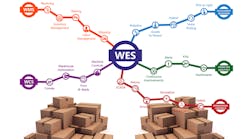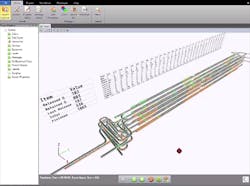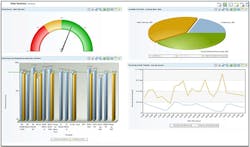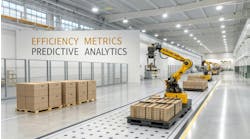When your warehouse or distribution operations are flowing smoothly, it’s easy to become complacent. Why fix what’s not broken, you might ask. Why go looking for trouble?
There are, however, some very good reasons to take steps to optimize asset operation. The first is simply that performance of aging equipment is likely degrading and may even be subject to unanticipated failure. The second is that this is coming at a time when the need for continuous improvement is more urgent than ever. E-commerce and omni-channel distribution are driving market expectations for rapid delivery and putting new pressure on logistics channels. Sustained success requires continuously finding new ways to cut costs, add value to operations or otherwise strengthen competitiveness.
It is no longer possible to view your operations through a rear-view mirror. Today is about viewing operations in real-time, making decisions on-the-fly and anticipating future opportunities and challenges. This requires reaching into disparate data sources and making that data visible to those who can turn it into actionable information to fuel continuous improvement. To accomplish this, facilities managers are increasingly turning to warehouse execution solutions that synchronize existing automation assets with each other and with the people who manage and operate them.
The Need for Warehouse Execution
Warehousing and distribution centers (DCs) typically involve high volumes of repeated operations and have traditionally gained significant value from automating manual tasks. The first wave of material handling automation involved conveyance systems, which were eventually augmented by advanced sortation systems and automated storage and retrieval systems (AS/RS). These systems involved coordination of many subsystems and warehouse control systems (WCSs) emerged to enable centralized control of this equipment.
The WCSs provided a degree of centralized control over machine operations, but did not address the business operations—such as order processing, inventory management, picking and shipping—upon which performance also depended.
Figure 1 illustrates the solutions that have evolved over the years. In addition to the control and management technologies mentioned, there are fulfillment solutions, such as picking to voice or light and robotic picking. There are optimization solutions such as predictive analytics around KPIs and continuous improvement initiatives; and there are operational controls, such as computerized maintenance management, operating alerting and supervisory control and data acquisition systems (SCADA). These solutions represent multiple vendors, none of which provide all solutions.
While all such operations generate a wealth of valuable data that could improve productivity, that data too often remains stranded in the equipment controls or in isolated zones. One part of the line usually doesn’t know what is going on beyond their zone. If there are problems or inadequate loading of a conveyor, for example, downstream pickers could be sitting idle for extended time periods until it was resolved. Or, if the inefficiencies were downstream, the pickers could be flooded with more items than they could handle. Either way, the result could be costly.
While lack of coordination has always been a risk, favorable economic conditions tend to be more tolerant of inefficiency. Today’s volatile, accelerating business conditions, however, are putting new strain on margins and the agility to synch operations to fluctuating demand is critical to profitability—even survival. This requires more attention to the integrated execution of all system and human activity, which is what warehouse execution systems provide. Warehouse execution systems (WESs) have the connectivity necessary to reach into disparate automation systems, extract operational data and get it to the people who need it. They can help maximize return on investment in both material handling equipment and human resources.
Warehouse Execution in Action
Synchronizing human and automation system operation in pick module flow control provides a good example of how a WES can tap into hidden value. In this real-world example, the facility’s WMS released orders in waves corresponding with customer service levels defined by contracted delivery dates. Each order was characterized by designated transportation target times, conveyor routings, junctions and merges. Figure 2 illustrates the resulting automated pick module.
In normal operation of this module, the WMS introduced cartons into Zone 1 of the system (lower left hand corner of Figure 2). If order volume got too high, however, that zone would fill up, causing the cartons to recirculate, idling operators on some parts of the line while potentially overwhelming those on others.
Balancing operator deployment in this case required an automated pick module that coordinated order flow data from the WMS with the machine controls of the conveyor and picking systems and sharing that information with operators in real-time. The WMS was reconfigured to release products based on an algorithm that factored in the designated transportation cutoff time, work that had already been released to the pick zone, and work that had already been processed. By looking at these usually disparate factors simultaneously, the WMS could calculate line capacity before releasing product to it, accounting for unanticipated production changes that may have occurred after an order was issued.
In addition to rationalizing order feed control, the WES enabled operators to adapt to the fluctuations in workflow as well. They were given screens that would reveal bottlenecks so they could shift dynamically. The system could also be configured to provide voice alerts directing them to log out of low-load zones and move an overloaded zone. The result was a 20% improvement in productivity in an operation that the warehouse manager had believed was already operating at peak efficiency.
Key Components of a WES
WESs capture data from devices and processes regardless of vendor brand. They interrogate multiple disparate data sources and turn that data into actionable information to streamline operations around order fulfillment, replenishment, inventory, transportation, purchasing and other aspects of the organization. Key elements include an operator interface, connectivity, analytical and optimization tools, and reporting capabilities.
Operator interfaces
Operators must have some way to visualize operations and required interventions. The example above provided operators with dashboards that highlighted pinchpoints, supplemented by proactive alerts that saved the operator the need to keep an eye on the monitor. Operators need the ability to instantly access the information they need to do their jobs, as well as an overview of the entire operation. As shown in Figure 3, dashboards may use speedometers, colored lights and other graphics, custom-built around the decision support data that each operator requires.
Connectivity
How systems access operating information will vary from warehouse to where the operator interface is usually connected to an Ethernet or similar network, which receives information from control units, sensors, machine controls over industrial communications protocols such as human-machine interfaces, PLCs and the like.
Analytical and optimization tools
The more accurately facilities managers can predict labor requirements, space availability, workflow and other variables, the more effectively they can operate their facilities. WESs make it easier to combine information from disparate solutions and provide tools for automated tracking of key operating variables, spotting anomalies and picking up on trends. The result is a forward-looking view of workflow, adjustments to labor and inventory prior to issues arising. Trending analysis supports refinement of future operations for long-term savings on labor costs, space allocations and workflow.
Reporting
In addition to providing real-time information for real-time decision support, WESs make it easier to parse that data for internal planning and reporting. Figure 4, for example, shows a workflow report generated by a warehouse execution system. It depicts performance levels of a distribution center by end-user and work type, revealing where workflow is hanging up or where it is accelerating, enabling process regulation and optimization.
While such data is applied in day-to-day operational improvement, it can also support longer term staff and equipment resource planning.
Continuous Improvement
Spot optimization initiatives deliver maximum value as part of an ongoing continuous improvement program. Continuous improvement programs usually identify the key performance indicators that help the warehouse or DC gauge and implement improvement initiatives. In addition to the line productivity improvement KPI used in the above example, the following might guide continuous improvement programs that can be synchronized within a WES:
• Alerts to potential work stoppage
• Putaways
• Replenishments
• Backfill and restocking
• Fork work
• General performance of labor
• Performance by warehouse to compare against
• Outbound shipments vs expectations.
Future-proofing
Most industry watchers these days are predicting a gap between the need for industrial workers and the number of qualified people available to meet the demand. Improving warehouse execution can reduce training time by capturing and storing standard procedures and guiding operators and pickers in following them. Implementing a warehouse execution system today can not only provide a platform for balancing future human resource needs, it can also potentially help with retention of current talent by making their work more productive and fulfilling.
Perhaps the greatest future-proofing benefits that WESs deliver, however, is their ability to reconcile data from multiple sources. As devices become more intelligent and more connected, through initiatives such as the industrial Internet of things (IoT), Industry 4.0 and Big Data management, the need to turn the flood of information into an asset rather than an overwhelming flood becomes increasing critical. This evolution, which is already well underway, not only makes the need for warehouse execution more critical, it will also yield tools and technologies that will make it easier to do.
Chris Capshaw is senior vice president for software solution sales and Randy Marble is vice president for software strategy with Wynright Corp., a wholly owned subsidiary of Daifuku North America, and a provider of intelligent material handling systems.






